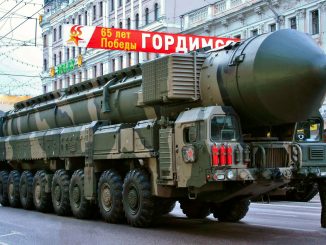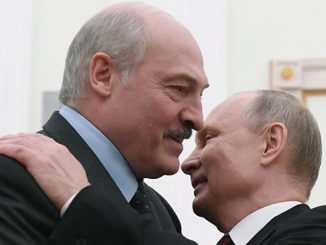« Putin is preparing for prolonged conflict in Ukraine during which he still intends to achieve goals beyond the Donbas… One of the key challenges is assessing how various threats and trends are likely to intersect »…
Source C-Span: Hearing on « Global Threats and National Security » of Director of National Intelligence, Mrs Avril Haines, before the Senate Armed Services Committee. Washington D.C., May 10, 2022 — Transcript by Eric H. Biass.
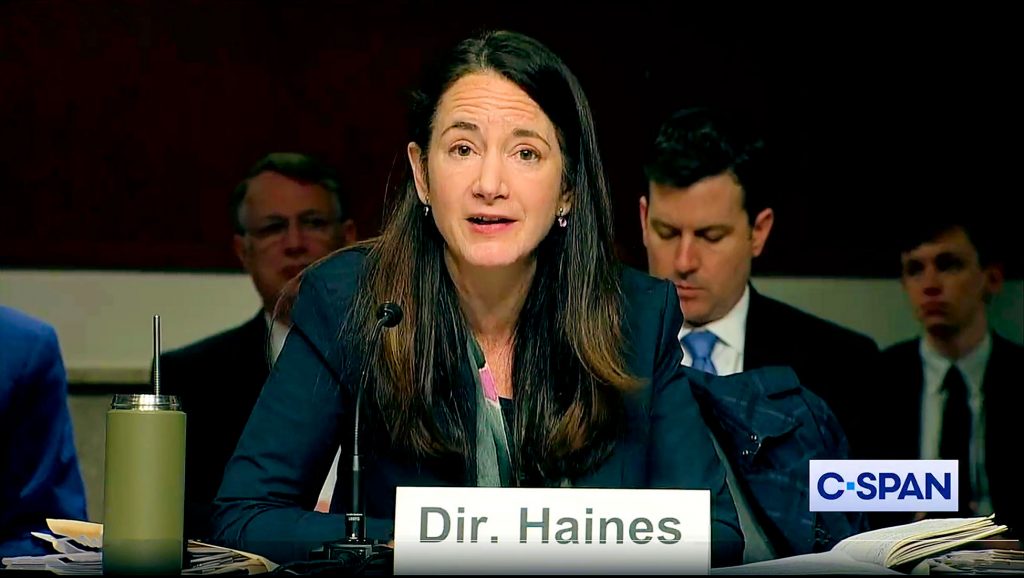
Thank you very much, chairman Reed, member Inhofe, members of the community. Thank you for allowing me to speak here today provide testimony alongside general Barrier on the intelligence community’s assessment of worldwide threats to US national security.
Before I start, I just want to take a moment to publicly thank the men and women of the intelligence community for their extraordinary work to keep us safe. I know how privileged I am to be a part of this community of truly talented people, to be given a chance to do something useful and service to my country. And I thank you for support, for your work.
Broadly speaking, this year’s assessment focuses much like last year’s assessment on adversaries and competitors, critical transnational threats and conflicts and instability. These categories often overlap.
Cybercrime, for example, is a transnational threat will also being a threat that emanates from state actors. One of the key challenges of this era is assessing how various threats and trends are likely to intersect, so as to identify where their interactions may result in fundamentally greater risk to our interest that one might otherwise expect, or whether they introduce new opportunities.
This year’s annual threat assessment highlights some of these connections as it provides the IC’s (Intelligence Community) baseline of the most pressing threats to US national security. The assessment starts with threats from key state actors, beginning with the people’s republic of China, which remains an unparalleled priority for the intelligence community. And then turns to Russia, Iran and North Korea.
All four governments have demonstrated the capability and intent to promote their interests and ways that cut against U.S. and Allied interests. The PRC is coming ever closer to being a peer competitor and national security is pushing to a advance norms to its advantage, and is challenging the United States in multiple arenas, economically, militarily and technologically.
China is especially effective at bringing together a coordinated, government level approach to demonstrate strength and compel neighbors to acquiesce to its preferences – including its territorial and maritime claims, and assertions of sovereignty over Taiwan. A key area of focus for the IC is president Xi Jinping’s determination to enter Taiwan on its terms.
China would prefer a forced unification that avoids armed conflict, and it has been stepping up diplomatic, economic and military pressure on the island for years to isolate it and weaken confidence in its democratically elected leaders. At the same time, Beijing is prepared to use military force if it decides this is necessary. The PRC is also engaged in the largest ever nuclear force expansion and arsenal diversification in its history. It is working to match or exceed U.S. capabilities in space and present the broadest, most active and persistent cyber espionage threat to U.S. government and private sector networks.
Russia, of course, also remains a critical priority.
And is a significant focus right now, in light of President Putin’s tragic invasion of ukraine in February, which has produced a shock to the geopolitical order with implications for the future that we are only beginning to understand, but are sure to be consequential.
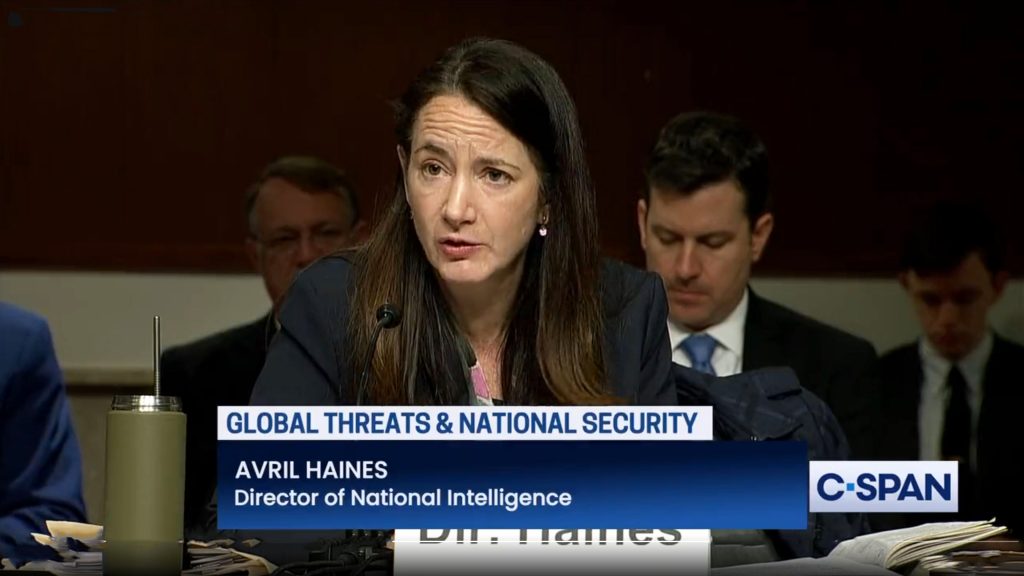
The IC, as you know, provided warning of Putin’s plans, but this is a case where we all wish we had been wrong. Russia’s failure to rapidly seize Kyiv and overwhelm Ukrainian forces has deprived Moscow of the quick military victory that it had originally expected to prevent the United States and Nato from being able to provide meaningful military aid to Ukraine.
The Russians met with more resistance from Ukraine that they expected, and their own military performance revealed a number of significant internal challenges, forcing them to adjust their initial military objectives, full back from Kyiv and focus on the Donbas. The next month or two of fighting will be significant, as the Russians attempt to reinvigorate their efforts but, even if they are successful, we are not confident that the fight of the Donbas will effectively end the war.
Beyond Donbas
We assess president Putin is preparing for prolonged conflict in Ukraine, during which he still intends to achieve goals beyond the Donbas. We assess that Putin’s strategic goals have probably not changed, suggesting he regards the decision in late March to refocus forces on the Donbas as only a temporary shift to regain the initiative after the Russian military’s failure to capture Kyiv. His current near term military objectives are to capture the two oblasts in Luhansk and Donetsk with a buffer zone, encircle forces from the north to the south and the west of the Donbas. In order to crash the most capable and well-equipped Ukrainian forces who are fighting to hold the line of the east, consolidate the control of the land bridge Russia has established from crimea to the Donbas, occupy Kherson and control the water source for Crimea, to the north.

We also see indications that the Russian military wants to extend the land bridge to Transnistria. While the Russian forces may be capable of achieving many of these near term goals in the coming months, we believe they will not be able to expand control over a land bridge that stretches to Transnistria and includes Odessa without launching some form of mobilization.
It is increasingly unlikely that they will be able to establish control over both oblasts and the buffers they desire in the coming weeks. But Putin most likely also judges that Russia has a greater ability and willingness to endure challenges than his adversaries. And he is probably counting on U.S. and EU resolve to weaken as food shortages, inflation and energy prices gets worse. Moreover, as both Russia and Ukraine believe they can continue to make progress militarily we do not see a viable negotiating path moving forward, at least in the short term.
The uncertain nature of the battle, which is developing into a war of attrition combined with the reality that Putin faces a mismatch between his ambitions and Russia’s current conventional military capabilities, likely means the next few months could see as moving along a more unpredictable and potentially escalatory trajectory.
At the very least, we believe the dichotomy will usher in a period of more ad hoc decision-making in Russia, both with respect to the domestic adjustments required to sustain this push, as well as the military conflict with Ukraine and the West.
Turning More Drastic
The current trend increases the likelihood that president Putin will turn to more drastic means, including imposing martial law, reorienting industrial production, or potentially escalatory military actions to free up the resources needed to achieve his objectives as the conflict drags on, or if he proceeds that Russia is losing in Ukraine.
The most likely flash points for escalation in the coming weeks are around increasing Russian attempts to interdict Western security assistance, retaliation for Western economic sanctions or threats to the regime at home. We believe that Moscow continues to use nuclear rethoric to deter the United States in the West from increasing lethal aid to Ukraine or to respond to public comments of the US and Nato allies that suggest expanded Western goals in the conflict.
If Putin proceeds that the United States is ignoring his threats he may try to signal to Washington the hightened danger to support to Ukraine by authorizing another large nuclear exercise, involing a major dispersal of mobile intercontinental missiles, strategic bombers, strategic submarines. We otherwise continue to believe that president Putin would probably only authorize the use of nuclear weapons if he perceived and existential threat to the Russian state or regime. But, we will remain vigilant in monitoring every aspect of Russia’s strategic nuclear forces.
With tensions this high there is always an enhanced potential for miscalculation, unintended escalation, which we hope our intelligence can help to mitigate. Beyond its invasion of Ukraine, Moscow presents a serious cyber threat, a key space competitor and one of the most serious foreign influence threats to the United States. Using its intelligence services, proxies, wide ranging influencing tools the Russian government seeks to not only pursue its own interests but also to divide Western alliances, undermine U.S. political standing, amplify discord within the United States, and influence U.S. voters and decision-making.
And Iran
And to finish with our state actor threats, the Iranian regime continues to threaten the U.S. interest as it tries to erode US influence in the Middle East, and enhance its influence and project power in neighboring states and minimise threats to regime stability.
Meanwhile, Kim Jong-Un continues to steadily expand and enhance Pyongyang’s nuclear and conventional capabilities, targeting the United States and its allies, periodically using agressive and potentially destabilising actions to reshape the regional security environment in his favor and to reinforce his status quo as a de facto nuclear power.
The assessment continues to focus on a number of key global and transnational threats including global health security, transnational organized crime, the rapid development of destabilising technologies, climate, migration, and terrorism. I raise these because they posed challenges of a fundamentally different nature to our national security than those posed by the actions of nation states, even powerful ones like China and Russia.
We look at the Russia Ukraine war and can imagine outcomes to resolve the crisis, and the steps needed to get there even though they are unpalatable and difficult, and similarly we view the array of challenges Chinese actions pose and can discuss what is required, how we think about trade-offs. But, transnational issues are more complex, require significant and sustained multilateral effort, and though we can discuss ways of managing them, all of them pose a set of choices that will be more difficult to untangle and more, perhaps require more sacrifice to bring about meaningful change.
This reflects not just the interconnected nature of the problems, but also the significant impact increasingly empowered non state actors have on the outcomes and the reality of some countries that are key to mitigating threats posed by nation states are also the ones we will be asking to do more in the transnational space.
For example, the lingering effects of the covid-19 pandemic is putting a strain on governments and societies, fueling humanitarian and economic crises, political unrest, and geopolitical competition. Low income countries with high debt face particularly challenging recoveries, now exacerbated in some cases by increasing food insecurity resulting from the Russia-Ukraine crisis. These shifts will spur migration around the world including on our southern border. The economic impact has set many poor and middle income countries back years in terms of economic development and is encouraging some of Latin America, and Asia to look to China and Russia for quick economic and security assistance to manage their new reality.
We see the same complex mix of interlocking challenges stemming from the threat of climate change, which is exacerbating risks in U.S. national security interests across the board, but particularly as it intersects with environmental degradation and global health challenges.
Terrorism
And terrorism, of course, remains a persistent threat for US persons and interests at home and abroad.
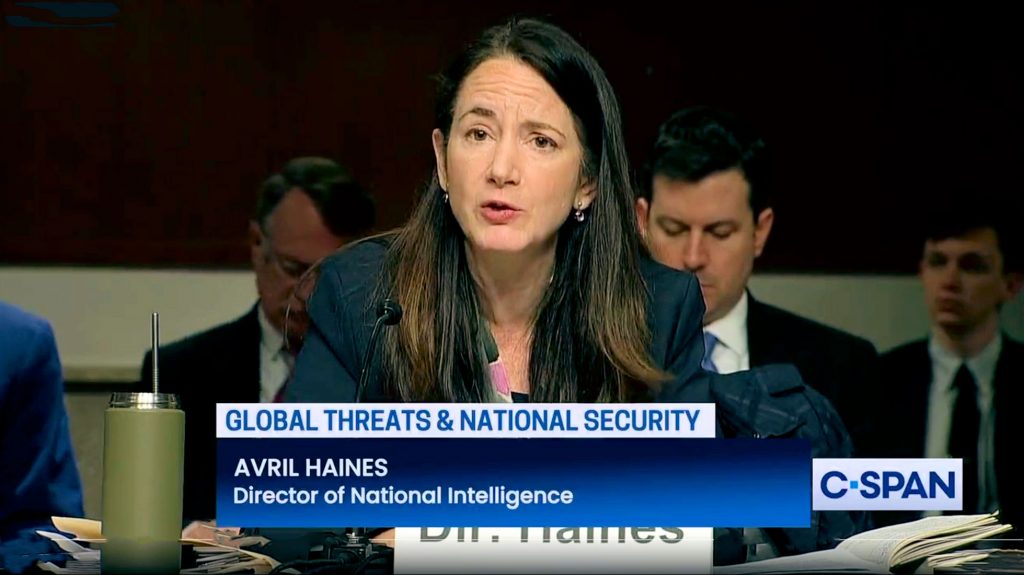
The implications of the problem are evolving. In Africa, for example, where terrorist groups are clearly gaining strength and the growing overlap between terrorist criminal activity and smuggling networks has undermined stability, contributed to coups and an erosion of democracy and resulting in countries turning to Russian entities to help manage these problems.
Global transnational criminal organizations continue to pose a direct threat to the United States through the trafficking of lethal, illicit drugs, massive theft, including cybercrime, human trafficking, financial crimes, and money laundering schemes ; and particularly the threat from illicit drugs is at historic levels with more than 100,000 American drug overdose deaths for the first time annually. Driven mainly by a robust supply of synthetic opioids from Mexican transnational criminal organizations.
In short, the interconnected global security environment is marked by the specter of conflict, while transnational threats to all nations and actors compete not only for attention but also for finite resources.
Finally, the assessment turns to conflicts and instability, highlighting a series of regional challenges of importance to the United States.
Iterative violence between Israel and Iran and conflicts in other areas including Africa, Asia, and the Middle East have the potential to escalate or spread, fuelling humanitarian crises and threaten U.S. persons. Africa, for example, has seen six irregular transfers of power from 2020 and will probably see new bouts of conflict in the coming year, as the region becomes increasingly strained by a volatile mixture of democratic backsliding, intercommunal violence, and the continued threat of cross border terrorism. Finally, and most important of all we are focused on our workforces and their families.
The IC continues to contribute to the government wide effort to better understand potential causes of mechanisms of anomalous health incidences and remains committed to ensuring that afflicted individuals receive the quality care they need. The safety and the well-being of our workforce is our highest priority and we are grateful to members of this committee for their continued support on those issues. Thank you for the opportunity presented assessments and I look forward to your questions.
See also: « L’évolution des menaces mondiales sur la sécurité des États-Unis ». Traduction de l’audition de Mme Avril Haines, directrice du renseignement national US, sur les menaces mondiales et la sécurité nationale, devant la commission des services armés du Sénat. Washington D.C., le 10 mai 2022.











